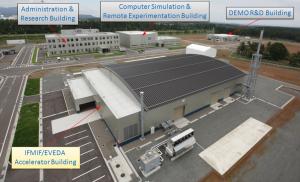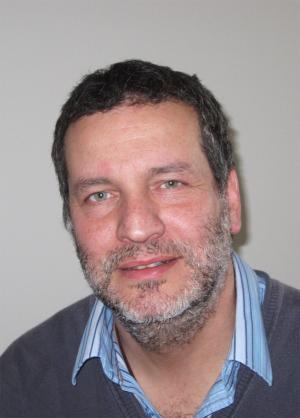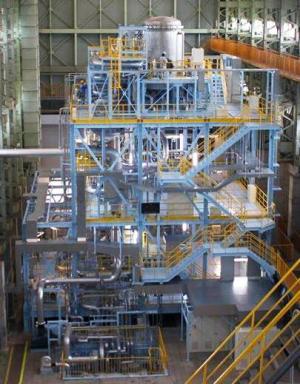IFMIF: paving the way for DEMO(s)
As IFMIF/EVEDA Project Leader since 16 June 2012, Juan Knaster is spearheading one of the three pillars of the Broader Approach, preparing for the construction of a materials test facility for future fusion reactors. He leads the European-Japanese Integrated Project Team for IFMIF/EVEDA, taking over from Pascal Garin and the interim Project Leader Hiroshi Matsumoto. For Newsline, he talks about the current status of the project, the importance of IFMIF for the future of fusion energy, and the appeal of life in Japan.
The International Fusion Materials Irradiation Facility (IFMIF) is presently in the Engineering Validation and Engineering Design Activities (EVEDA) phase. Can you describe the project's framework, its objectives?
Fusion-relevant neutron sources are indispensable for the world's common effort to develop nuclear fusion as a limitless source of energy for humankind. IFMIF/EVEDA is one of the three projects of the Broader Approach Agreement between Japanese government and Euratom signed in 2007 concurrently with the start of ITER Organization. The Broader Approach is a beautiful example of a smooth and collaborative multicultural scientific collaboration sharing goals across the world. It is an honour for me to lead one of its pillars and I can tell you that daily I enjoy the constructive spirit that pervades its working atmosphere. The EVEDA phase was conceived as a risk contention exercise—by building prototypes of the main technological challenges of IFMIF we are accurately determining the cost involved and the construction schedule. In addition, the engineering design of the IFMIF plant is also in our mandate; it will be mature to successfully drive IFMIF construction as soon as our community asks for it.
What is the status of the different IFMIF facilities?
IFMIF includes three main facilities: the Accelerator facility, the Target facility, and the Test facility. The validation activities are based on the construction of prototypes for the three facilities aforementioned to demonstrate their technological feasibility. A deuteron accelerator of 125 mA beam intensity and first accelerating stage to 9 MeV is under installation in Rokkasho; a liquid Lithium loop reaching 15 m/s of flow speed is presently running in Oarai in parallel with the development of its diagnostics and remote handling; finally the High Flux Test Module with a helium cooling loop and heaters capable of controlling the irradiation temperature of small specimens has been developed by KIT (Germany) and last but not least the Creep-Fatigue test module prototype made by CRPP in Villigen, Switzerland. [Editor's note: the Creep-Fatigue module is the prototype that will test creep-fatigue* behaviour in IFMIF under neutron irradiation.]
What will happen after EVEDA? Who will build the actual IFMIF? Where, and when?
We don't know yet where and when IFMIF will be built. The success of ITER will drive the enthusiasm of DEMO construction—even possibly various DEMOs around the world—which will demand fusion-relevant neutron sources to give timely answers to engineers facing the design of the reactor. It is my personal feeling that as there will probably be various DEMOs, there will be various neutron sources. The concept that IFMIF/EVEDA is developing as neutron source will be nicely placed to become the solution in a rapid manner.
Why is IFMIF so important for the future of fusion energy?
There are two available types of neutron sources nowadays, fission reactors and spallation facilities. Fission neutrons present an average energy of around 2 MeV; in turn, spallation neutron sources present a wide energy spectrum with tails in the order of hundreds MeV that generate light ions in significant quantities through transmutation. Materials facing the plasma in DEMO and future fusion power plants will be impacted by an unprecedented flux of 14.1 MeV neutrons. The degradation of the materials in the first wall of the reactor vessel is driven by the accumulation of transmuted helium and hydrogen in the material lattice that drives their embrittlement. However, the transmutation energy threshold of incident neutrons is around 3 MeV. Neither fission reactors nor spallation sources are fully suited. ITER will present less than 3 displacements per atom (dpa) in its full operational life; however in certain regions of its first wall DEMO will present around 30 dpa/year in full power operational mode. IFMIF will provide over 20 dpa/year in its High Flux Test Module capable of housing around 1000 small specimens with fusion-relevant neutrons. Investigating the degradation of materials exposed to plasma in a fusion reactor and understanding its fundamentals is essential to efficiently operate a power plant. Material scientists need relevant irradiation data in the operational range of a fusion reactor; presently we don't know how the thermomechanical properties of materials will degrade with neutron bombardment in a fusion power plant.
Some of the ITER Members already have a schedule for building DEMOs. How will these schedules coincide with IFMIF's?
The finalization of the EVEDA phase by mid-2017 will allow us to face the construction of IFMIF with a full guarantee of success and, as I said, with an accurate understanding of cost and schedule thanks to the validation activities and the Engineering Design of IFMIF plant presently under preparation. IFMIF's concept (two 40 MeV deuteron accelerators with a tuned current of 125 mA each impacting on a liquid Li screen that will generate neutrons with a broad peak at 14 MeV in the forward direction through (d, Li)n stripping reactions) is significantly simpler than ITER; its construction will possibly take slightly more than five years, but within a couple of years of operation fusion-relevant data on materials degradation will be available. The common efforts of Japan and Europe framed by the Broader Approach will allow world DEMOs to become a reality.
You were appointed IFMIF/EVEDA Project Leader in June 2012. How do you look back on your ~ 9-month experience in Japan from a professional, personal and cultural point of view?
I love Japan, its people, its gastronomy and its respect for old traditions. I feel at ease in the wonderful organized chaos that one can experience in its big towns like Tokyo, undoubtedly one of the most fascinating towns in the world. During my time at ITER from 2005 on, as an engineer leading the design of the toroidal field coils, I had the opportunity to visit Japan very often and I built personal links. Things have evolved as I expected since my arrival: there have been no bad surprises! I feel comfortably integrated in Japan and hope to soon be fluent in Japanese. On a professional ground, I must also say that JAEA staff has been very supportive and accepting of my leadership. I was nicely surprised with the high quality and amount of work of IFMIF community. My life drive is learning and there are new fascinating technological fields I am deeply involved with like neutronics, liquid metals, accelerator beam physics, nuclear safety...
* A mechanical characteristic, creep describes plastification occurring under constant stress below the elastic limit. Fatigue is the degradation of stiffness under cyclic loads.




